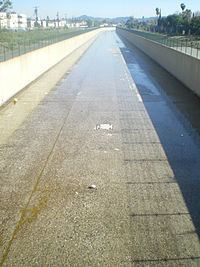Country United States of America | ||
 | ||
Similar | ||
Tujunga Wash is a 13.0-mile-long (20.9 km) stream in Los Angeles County, California. It is a tributary of the Los Angeles River, providing about a fifth of its flow, and drains about 225 square miles (580 km2). It is called a wash because it is usually dry, especially the lower reaches, only carrying significant flows during and after storms, which usually only occur between November and April.
Contents
Map of Tujunga Wash, Los Angeles, CA, USA
About
Tujunga Wash consists of two forks, both beginning in the San Gabriel Mountains. The upper portion of Big Tujunga Wash is called Tujunga Creek, or Big Tujunga Creek. It travels roughly east to west, and several tributaries from the north and south join it as it flows to Big Tujunga Reservoir, formed by Big Tujunga Dam. Below the dam, the stream is called Big Tujunga Wash. It continues its westward flow, enters San Fernando Valley and is met by Little Tujunga Wash a mile before reaching Hansen Reservoir, which is formed by Hansen Dam. Little Tujunga Wash comes from the north, draining the portion of the San Gabriel Mountains immediately north of Hansen Reservoir. Downstream of the dam, Tujunga Wash flows roughly south and is met halfway to its confluence with the Los Angeles River by Pacoima Wash, which drains the other side of the mountains that Little Tujunga Wash drains. Finally, Tujunga Wash meets the Los Angeles River near Studio City, California.
Big Tujunga Dam was built by Los Angeles County and completed in 1931. Big Tujunga Reservoir can hold 5,960 acre feet (7,350,000 m3) of water. In the Los Angeles Flood of 1938 it was tested. The dam is currently undergoing a seismic retrofit, which includes doubling the thickness of the gravity arch dam. Hansen Dam was built by the United States Army Corps of Engineers and completed in 1940. Hansen Reservoir can hold 74,100 acre feet (91,400,000 m3) of water. Their primary purposes are flood control, although they also provide some groundwater recharge. Water cannot percolate in the lower portion of the watershed because it is so urbanized that there is little bare ground and streambeds have been transformed into concrete channels, and the water flows too fast in the upper reaches of the watershed to sink into the ground very much. As a result, the majority of the water is discharged into the ocean.
In 1969 there was a flood in the Tujunga Wash: water flowed down a formerly inactive channel and entered a large gravel pit 15 m to 23 m deep. The channel bed degraded by about 4 meters, leading to failure of three highway bridges and loss of seven homes.
Crossings
From north to south (year built in parentheses):
